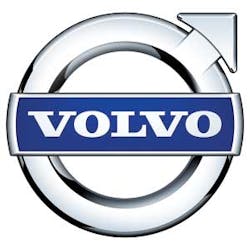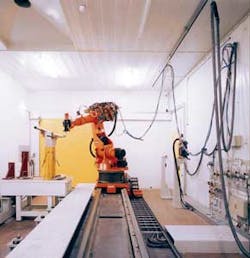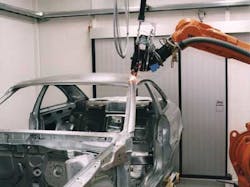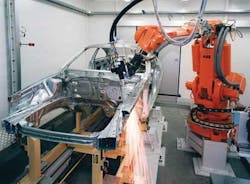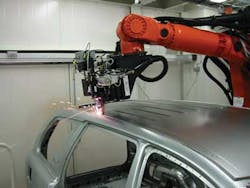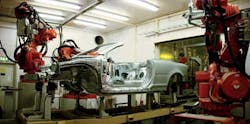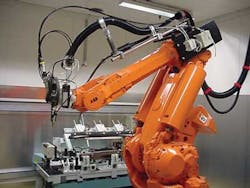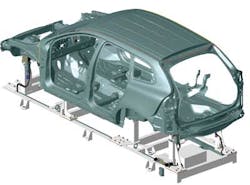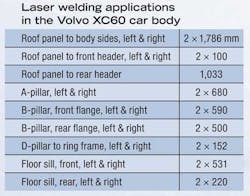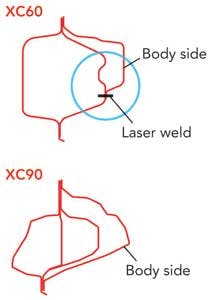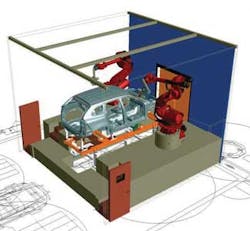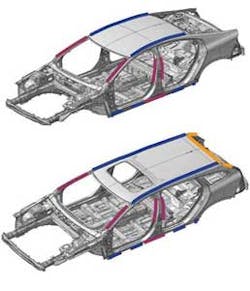Laser development at Volvo
JOHNNY K. LARSSON
Today, it is common for global automotive manufacturers to use some kind of laser processing in their production, such as cutting, welding, marking, hardening, or surface treatment. Therefore, it is easy to forget the pioneering work that took place during the 1980s that made possible the extensive introduction of lasers seen in body shops today. The fact that the Volvo Car Corporation was one of the first companies to utilize this production technology is especially gratifying to the author, who was personally involved.
Volvo was the first European car manufacturer to introduce laser welding in the main line of the body shop with the start of production (SOP) of the "850" model in the Gent plant in Belgium in autumn 1991. It is agreed that BMW (Bayerisches Motorenwerk) put roof laser welding in production on the 3 Series touring model a couple of months earlier, but this welding operation was performed as a sub-assembly next to the main line. The very first on-line assembly laser welding operation actually appeared in the US in 1988 when General Motors started joining part of the roof attachment to the rear quarter panels on the Chevrolet Baretta and Corsica in their Linden, NJ, plant.
CO2 lasers
During that time, CO2 lasers dominated this business as they were the only type of source that could offer the 5-6 kW output power necessary for these welding operations. In parallel, the automotive industry had started to use the CO2 laser as a cutting tool, which gave them the opportunity to acquire initial knowledge about laser processing. This was also the case at Volvo, which built its first laser cell in 1984 at the Torslanda Pilot plant in Gothenburg, Sweden, which was equipped with a 5-axis gantry robot and a 1 kW transverse-flow CO2 laser from Rofin Sinar. The laser power level was considered necessary to cut thin steel sheet body panels, with a thickness around 1 mm, at a reasonable speed. The cutting tool was equipped with capacitive height sensing to guarantee correct positioning of the focal spot relative to the part when cutting complex three-dimensional body components.
This installation was mainly used for hole- and contour-cutting of prototype parts that had lot sizes between 50-100 units, where it would not have been economically justifiable to invest in individual hard cutting tools. Thus laser cutting presented considerable time and cost savings, while simultaneously producing a cut quality that was superior to that achieved using manual cutting and drilling procedures. This first laser source became a work-horse and was operational until 1997, when it was replaced by a 1,700 W fast-axial-flow CO2 laser.
In 1988, laser operations at the Torslanda Pilot plant were extended with a 6 kW transverse-flow CO2 laser with a matching 6-axis gantry robot, and the development work on laser welding started. This occurred because design and manufacturing engineers saw that laser welding offered superior joint strength, a narrower tolerance range due to less heat input, a better overall finish, and single-sided processing that made new design solutions possible. The latter was something that the Volvo engineers noted when they started the design of the 850 model, where the roof rail was made as a closed section to guarantee sufficient side impact protection. This design limited the choice of assembly methods to either adhesive bonding or laser welding. Laser welding came out the winner in terms of product performance as well as reliability in production, and the decision was made to put this technology into high volume car body production [1-4].
Today, solid state lasers dominate when it comes to cutting and welding of passenger car bodies, but it took a long time until laser manufacturers were able to offer sources with sufficient high power and acceptable beam quality. Initially Volvo used 400 W JK lasers from Lumonics, and in 1989 three of these were connected in parallel for a total power output of 1.2 kW. The beam quality may have been inferior, but this was a first step in cutting and welding with a Nd:YAG laser.
The first "real" high power Nd:YAG laser was installed at the Torslanda Pilot plant in 1995 [5]. It was a 2.5 kW unit from Rofin Sinar with four cavities, eight flash lamps, and a beam quality of 25 mm*mrad. The laser beam was guided through a fiber optics delivery system to a dedicated tool mounted on an articulated arm robot which in turn was mounted on a conveyor track in order to offer maximum flexibility (FIGURE 1). This processing cell has gradually been extended and upgraded and today contains a 4 kW diode-pumped disc laser, a leased 6 kW diode laser, two separate working stations, three robots, and a great number of processing tools, including seam tracking devices and process monitoring systems.The Volvo C70
The initial Nd:YAG installation intended for production came with the introduction of the first generation of the Volvo C70 model in 1997 [6, 7]. The production was located in a newly established company, AutoNova, which was a joint venture (JV) between Volvo Cars and Tim Walkinshaw Racing (TWR) situated in the small town of Uddevalla, 50 km north of Gothenburg. Here, Volvo introduced another "World's First": laser welding and cutting in the same production cell on the main assembly line (FIGURE 2) in a plant with a capacity of 20,000 cars per year. The installation contained a 2 kW Nd:YAG laser, a standard articulated arm robot, and a tool changing unit that could switch between welding and cutting tools. The applications were roof laser welding of the coupé version and precision hole cutting in the front spring towers of all models for subsequent attachment of the MacPherson front suspension struts.1996. The laser welding cell in the Gent plant was upgraded with a second laser source, and at the same time the gantry robot was substituted with a robotized solution similar to the one in Torslanda.
2000. This year was the SOP of the successful XC90 model where Volvo switched the location of the roof laser seam from the original overlap weld to instead perform a fillet weld solution, made possible through the introduction of a dedicated seam tracking device (FIGURE 4). This was also the occasion when Volvo for the first time used an Nd:YAG laser in high volume production [9].2001. The CO2 lasers in the Torslanda plant were replaced with 4 kW Nd:YAG units, which occurred during the introduction of the first generation of the S80 and V70 models.
2003. A new body shop (designated GA2), equipped with laser facilities, was inaugurated in the Gent plant to take care of the smaller Volvo models S40 and V50 when production of these were moved from the Dutch plant in the city of Born. The first laser cell outside Europe was introduced when the S40 model was launched for production in Pretoria in the Republic of South Africa.
2005. A completely new laser cell was introduced in the Uddevalla plant, where Volvo now started a new JV with the Italian automotive manufacturer Pininfarina, in conjunction with the launch of the second generation of the C70 model. This installation is unique in that it features laser welding and laser brazing in the same production cell (FIGURE 5) [11-13].The last CO2 lasers sources were taken out of production and lamp-pumped Nd:YAG lasers were substituted in the GA3 body shop line in the Gent plant.
2006. The second generation of the S80 was introduced, featuring a split laser brazed outer skin for the trunk lid, a component which is manufactured in the press shop in Olofstroem in southern Sweden (FIGURE 6) [14].XC60 body structure
Two innovative laser solutions in the XC60 body structure are the Smart A-pillar and the Reduced Body Side. In order to enhance the driver's visibility around the windscreen pillar, the flange to which the windscreen is bonded has been further inclined, which makes ordinary spot welding operations impossible as the welding gun cannot access such a confined space (FIGURE 8). Here, the only possible solution was to use laser welding.To perform this comprehensive amount of laser welding, two subsequent laser welding stations can be found in the GA3 body shop line in the Gent plant. The first one is the station upgraded in 2005 for laser welding of the roofs of the S60 and C30 models that also run in this line. That station is equipped with two 4 kW lamp-pumped Nd:YAG lasers with fiber optic beam delivery and two articulated arm robots equipped with combined seam-tracking and pressure roller tools.
The second station is a new one, necessary for the increased number of laser welded applications in the XC60 body (FIGURE 10). This cell features one diode-pumped Nd:YAG laser and one diode-pumped disc Yr:YAG laser, both with 4 kW laser output power. Also in this station can be found fiber-guided beam distribution to welding tools mounted on two articulated arm robots. All four robots are equipped with track motion, which makes 7th axis processing possible and allows further flexibility for other laser applications in upcoming products. This layout guarantees a 100% back-up and redundancy in case of any laser disturbances, and maintains the line speed in the GA-line, which is 67 sec.Conclusion
Further utilization of laser technology is expected in upcoming model programs where Volvo intends to continue to take advantage of the unique advantages offered by this technique, such as improved geometrical tolerances, minimum heat input on advanced high strength steel components, and the ability to create new design solutions due to single sided processing. Laser welding of aluminum, remote welding of closures, and contour cutting of in-house produced press-hardened components are just some of the challenges that are just around the corner, and further applications are considered that will help Volvo maintain its position as a world leader in design and production of safe and reliable body structures for all of our new models.
References
1. Larsson, J.K., "Laser technology - Making new engineering solutions possible," Proc. 3rd Conf. on Laser Materials Processing in the Nordic Countries, NOLAMP3, Lappeenranta, August 1991, ISBN 951-763-670-9.
2. Larsson, J.K., "One decade of experience from laser materials processing - A powerful foundation for improved product quality," Proc. 26th ISATA Conf. (plenary paper), Aachen, September 1993, ISBN 0 947719 57 1.
3. Hanicke, L. and Strandberg, Ö., "Roof laser welding in series production," Proc. SAE International Congress, Detroit, MI, March 1993.
4. Larsson, J.K., "The introduction of roof laser welding in car production and the development of a new fixation technique," Proc. Laser Assisted Net Shape Engineering, LANE'94, Erlangen, October 1994, Meissenbach Bamberg Verlag, ISBN 3-87525-061-3.
5. Larsson, J.K., "Focusing the Nd:YAG laser beam onto the automotive industry," Proc. Advances in Materials and Processing Technologies, AMPT'95, Dublin, August 1995.
6. Larsson, J.K., "The use of Nd:YAG lasers in future automotive applications," Proc. Laser Assisted Net Shape Engineering, LANE'97, Erlangen, September 1997, Meissenbach Bamberg Verlag, ISBN 3-87525-090-7.
7. Hanicke, L. and Johansson, G.: "From CO2 to Nd:YAG laser - Development of tools and adaptation to production of Volvo 850 and C70," Proc. Automotive Laser Applications Workshop, ALAW'97, Novi, MI, March 1997.
8. Larsson, J.K., "The mature technique of laser processing in body manufacture - Long term production experiences and recent developments," Proc. Laser Assisted Net Shape Engineering, LANE'01, Erlangen, August 2001, Meissenbach Bamberg Verlag, ISBN 3-87525-154-7.
9. Larsson, J.K. and Palmquist, N., "Laser welding on the new Volvo XC90," Proc. 9th Conf. on Laser Materials Processing in the Nordic Countries, NOLAMP9, Trondheim, August 2003.
10. Larsson, J.K., "Laser welding as a competitive joining method in body-in-white assembly; an automotive state-of-the-art report with complementary future challenges," Proc. 10th Conf. on Laser Materials Processing in the Nordic Countries, NOLAMP10, Piteå, August 2005.
11. Larsson, J.K. and Palmquist, N., "Extensive laser processing on the New Volvo C70 convertible," Proc. Automotive Laser Applications Workshop, ALAW'06, Plymouth, MI, March 2006.
12. Larsson, J.K., "Laserlöten - Eine neue technologie für kosmetische fugen in PKW rohbau," Tagungsband GroBe SchweiBtechnische Tagung, Aachen, September 2006.
13. Larsson, J.K., " Laser brazing - A new technology for cosmetic joints in the body structure," Proc. 11th Conf. on Laser Materials Processing in the Nordic Countries, NOLAMP11, Lappeenranta, August 2007.
14. Larsson, J.K. and Palmquist, N., "Various laser processing for the new Volvo S80 luxury sedan," Proc. 8th European Automotive Laser Applications Workshop, EALA, Bad Nauheim, January 2007.
15. Larsson, J.K. and Palmquist, N., "The Volvo XC60 - a novel model featuring new laser applications for increased car body strength properties and enhanced quality," Proc. 10th European Automotive Laser Applications Workshop, EALA, Bad Nauheim, February 2009.
16. Larsson, J.K., "Designed for laser welding," Industrial Laser Solutions, May 2009.
17. Larsson, J.K. and Palmquist, N., "Improved car body performance for the Volvo XC60 model through the extensive utilization of laser technology," Proc. 12th European Automotive Congress, EAEC, Bratislava, June 2009.
18. Larsson, J.K., "Avoidance of crack inducement when laser welding hot-formed car body components - A variable analysis," Proc. Laser Assisted Net Shape Engineering, LANE'10, Erlangen, September 2010.
19. Larsson, J.K., Palmquist N. and Todal U., "Challenges with laser welding in UHSS boron steels," Proc. 13th European Automotive Laser Applications Workshop, EALA, Bad Nauheim, February 2012.
20. Larsson, J.K. and Palmquist, N., "Two intensively laser welded body versions built on one platform and manufactured in two plants," Proc. 12th European Automotive Laser Applications Workshop, EALA, Bad Nauheim, February 2011.
Johnny K Larsson: An expert in joining technologies
Johnny K Larsson ([email protected]) is an M.Sc. graduate of the Technical University of Lund and is an internationally recognized expert in joining technologies for passenger car body structures. He is the author of more than 200 conference papers and he has contributed over 100 technical articles published in magazines in Europe, Japan, North and South America. He has also delivered innumerable presentations at international automotive conferences, where he has been recognized with several awards for excellence in oral presentations.
Larsson has been, or still is, the acting chairman at a number of international conferences dealing with joining technologies such as; SAE, IBEC, ISATA, NOLAMP, IIW, and ACI. He is the chairman of the Swedish Laser Association and he is active in the Swedish Welding Commission and the Swedish Agency for Innovation Systems. He is the sub-task leader in a number of European projects (EUCAR & Brite-EURAM) related to advanced body-in-white (BIW) joining and has contributed to the continuity of education for BIW engineers through his involvement in organizations like EUROMOTOR and ELA (European Laser Academy) as well as giving adapted courses at CTH and KTH.
He gained experience in heavy truck engineering at Fleron Co. International, customizing Volvo, Scania, Mercedes, MAN trucks and trailers. He followed this with 23 years experience in Body in White engineering at Volvo Car Corporation, familiar with all requirements and test procedures, and with specific knowledge in joining technologies, materials science, crashworthiness engineering, and structural mechanics.
Larsson has 15 years of competence in joining technologies, including all types of thin sheet metal welding (resistance, laser and gas metal arc), brazing technologies, mechanical joining and structural adhesive bonding and 15 years experience in harmonization of design guidelines, requirements and quality assurance for joining methods with Renault Automobiles, Ford Motor Company, LandRover and Jaguar Cars.
At Volvo he has been: R&D coordinator for BIW & exterior trim, responsible for the specification of BIW test requirements and he was responsible for BIW competitor analysis. He was the R&D coordinator BIW for Volvo/Renault and BIW joining coordinator for Volvo/Ford. He is now the technical specialist, BIW Joining Technologies, at Volvo.
